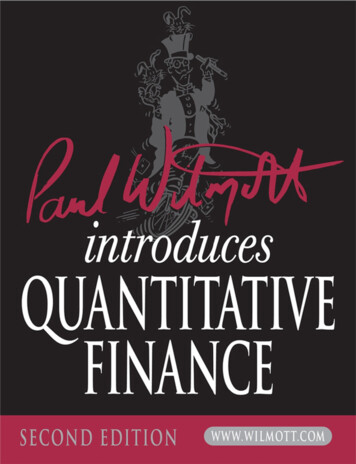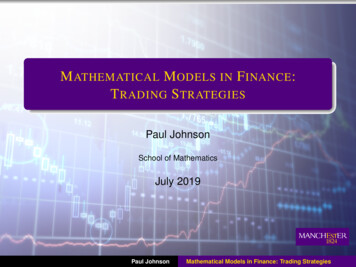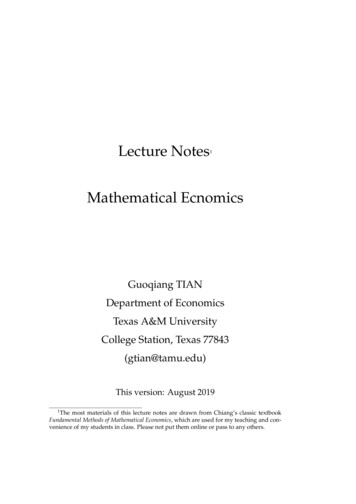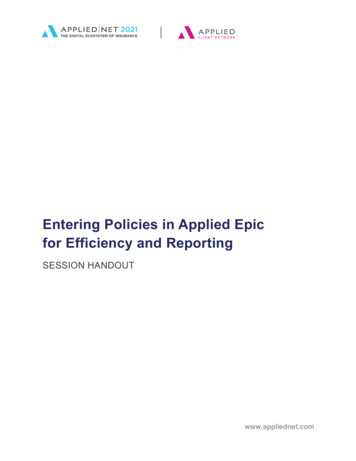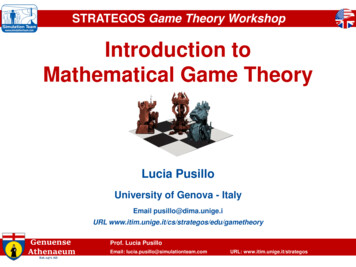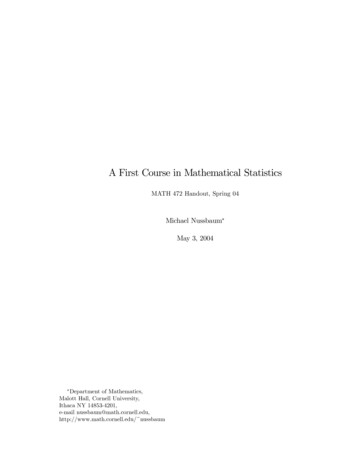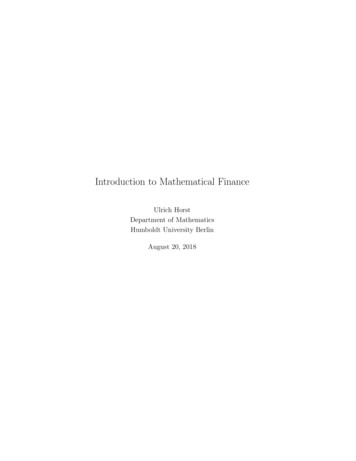
Transcription
Introduction to Mathematical FinanceUlrich HorstDepartment of MathematicsHumboldt University BerlinAugust 20, 2018
2
Contents1 Discrete Time Finance1.1 Introduction . . . . . . . . . . . . . . . . . . . . . . . . . . .1.1.1 The put-call parity . . . . . . . . . . . . . . . . . .1.1.2 Naive approaches to option pricing . . . . . . . . .1.2 Mathematical finance in one period . . . . . . . . . . . . .1.2.1 Assets portfolios and arbitrage opportunities . . .1.2.2 The Fundamental Theorem of Asset Pricing . . .1.2.3 Derivative securities . . . . . . . . . . . . . . . . . .1.2.4 Complete market models and perfect replication .1.2.5 Good deal bounds and super-deals . . . . . . . . .1.2.6 Indifference valuation and risk sharing . . . . . . .1.3 Dynamic hedging in discrete time . . . . . . . . . . . . . .1.3.1 The multi-period market model . . . . . . . . . . .1.3.2 Arbitrage opportunities and martingale measures1.3.3 European options and attainable claims . . . . . .1.3.4 Complete markets . . . . . . . . . . . . . . . . . . .1.4 Binomial trees and the Cox-Ross-Rubinstein Model . . .1.4.1 Delta-Hedgeing in discrete time . . . . . . . . . . .1.4.2 Exotic derivatives . . . . . . . . . . . . . . . . . . .1.4.3 Convergence to Black-Scholes Prices . . . . . . . .1.5 Introduction to optimal stopping and American options1.5.1 Motivation and introduction . . . . . . . . . . . . .1.5.2 Stopping times . . . . . . . . . . . . . . . . . . . . .1.5.3 The Snell envelope . . . . . . . . . . . . . . . . . .1.5.4 Decomposition of supermartingales and pricing of1.5.5 American options in the CRR model . . . . . . . .1.5.6 Arbitrage-free prices . . . . . . . . . . . . . . . . .1.5.7 The lower Snell envelope . . . . . . . . . . . . . . .1.6 Introduction to risk measures . . . . . . . . . . . . . . . .1.6.1 Risk measures and their acceptance sets . . . . .1.6.2 Robust representations of risk measures . . . . . .3. . . . . . . . . . . . . . . . . . . . . . . . . . . . . . . . . . . . . . . . . . . . . . . . . . . . . . . . . . . . . . . . . . . . . . . . . . . . . . . . . . . . . . . . . . . . . . . . . . . . . . . . . . . . . . . . . . . . . . . . . . . . . . . . . . . . . . . . . . . . . . . . . . . . . . . . . . . . . . . . . . . . . . . . . . . . . . . . . . . . . . . . . . . . . . . . . . . . . . . . . . . . . . . . . . . . . . . . . . . . . . . . . . . . . . . . . . . . . . . . . . . . . . . . . . . . . .American options . . . . . . . . . . . . . . . . . . . . . . . . . . . . . . . . . . . . . . . . . . . . . . . . . . . . . . . . . . . . . . . . . . 7505053
4CONTENTS1.6.31.6.4V@R, AV@R and shortfall risk . . . . . . . . . . . . . . . . . . . . . . . . . . . . .Law invariance . . . . . . . . . . . . . . . . . . . . . . . . . . . . . . . . . . . . . . .2 Continuous Time Finance2.1 Introduction to continuous time models and Pathwise Itô calculus2.1.1 Basic notions and classes of stochastic processes . . . . . . .2.1.2 Brownian motion . . . . . . . . . . . . . . . . . . . . . . . . .2.1.3 Quadratic Variation . . . . . . . . . . . . . . . . . . . . . . . .2.1.4 The basic Itô formula . . . . . . . . . . . . . . . . . . . . . . .2.1.5 The quadratic variation of Itô integrals . . . . . . . . . . . .2.1.6 Application: The Bachelier Model . . . . . . . . . . . . . . .2.2 Stochastic Calculus for Brownian Motion . . . . . . . . . . . . . . .2.2.1 The Itô Integral . . . . . . . . . . . . . . . . . . . . . . . . . .2.2.2 Itô integral for a larger class of integrands . . . . . . . . . .2.2.3 The Generalized Itô Formula . . . . . . . . . . . . . . . . . .2.2.4 The martingale representation theorem . . . . . . . . . . . .2.2.5 Application: The Black Scholes Model . . . . . . . . . . . . .2.3 Topics in diffusion theory . . . . . . . . . . . . . . . . . . . . . . . . .2.3.1 Stochastic differential equations . . . . . . . . . . . . . . . . .2.3.2 Solutions to linear SDEs . . . . . . . . . . . . . . . . . . . . .2.3.3 Change of variables and Girsanov’s theorem . . . . . . . . .2.4 Risk neutral pricing . . . . . . . . . . . . . . . . . . . . . . . . . . . .2.4.1 The market model . . . . . . . . . . . . . . . . . . . . . . . . .2.4.2 Equivalent martingale measures and absence of arbitrage .2.4.3 Option Pricing and PDE . . . . . . . . . . . . . . . . . . . . .2.5 The fundamental theorem of asset pricing in continuous time . . .2.5.1 Definitions . . . . . . . . . . . . . . . . . . . . . . . . . . . . .2.5.2 The Kreps-Yan theorem . . . . . . . . . . . . . . . . . . . . .2.5.3 The proof of the fundamental theorem of asset pricing . . .2.5.4 On the weak-*-closedness of C . . . . . . . . . . . . . . . . .3 Stochastic Optimal Control3.1 Introduction to basic concepts . . . . . . . . . . . . . . . . . . . . . . . . . . . . . . . .3.1.1 Examples of stochastic optimization problems . . . . . . . . . . . . . . . . . .3.1.2 Controlled diffusion processes . . . . . . . . . . . . . . . . . . . . . . . . . . . .3.1.3 Dynamic programming principle . . . . . . . . . . . . . . . . . . . . . . . . . .3.1.4 Hamilton-Jacobi-Bellman equation . . . . . . . . . . . . . . . . . . . . . . . . .3.1.5 Application: Portfolio optimization for power utilities . . . . . . . . . . . . .3.2 Viscosity solutions . . . . . . . . . . . . . . . . . . . . . . . . . . . . . . . . . . . . . . .3.2.1 Framework, Motivation and Definition . . . . . . . . . . . . . . . . . . . . . .3.2.2 From the value function to a viscosity solution of HJB via DPP . . . . . . .3.2.3 From the viscosity solution to the value function via a comparison principle5558.59. 59. 59. 60. 61. 64. 65. 66. 69. 70. 73. 74. 78. 79. 83. 83. 85. 87. 90. 91. 92. 96. 97. 98. 100. 100. 101.105105105107109110111113114116118.
CONTENTS3.33.2.4 Comparison principles . . . . . . . . . . . . . .Backward Stochastic Equations and Optimal Control3.3.1 Existence and uniqueness results . . . . . . . .3.3.2 Control and BSDE . . . . . . . . . . . . . . . .3.3.3 Application: Portfolio optimization . . . . . .5.119122122125127
6CONTENTSForewordThe objective of this one year course is to give an introduction to the probabilistic techniques required to understand the most widely used models of mathematical finance. The course is intendedfor undergraduate and graduate students in mathematics, but it might also be useful for students ineconomics and operations research.The focus of the first semester is on stochastic models in discrete time. This has at least two immediatebenefits. First, the underlying probabilistic machinery is much simpler; second the standard paradigmof complete financial markets akin to many continuous time models where all derivative securities admit a perfect hedge does typically not hold and we are confronted with incomplete models at a veryearly stage. Our discussion of (dynamic) arbitrage theory and risk measures follows the textbook byFöllmer & Schied (2004). The chapter on optimal stopping and American options follows Section 2of Lamberton & Lapeyre (1996).The second semester treats stochastic finance in continuous time. We discuss pathwise Itô calculus as well as selected topics in stochastic analysis such as Itô integrals, the change of variable formula(Girsanov’s theorem), the martingale representation theorem and stochastic differential equations.They constitute the building blocks of continuous time financial mathematics including the famousBlack-Scholes option pricing formula. Here we follow the textbooks by Lamberton & Lapeyre (1996)and Øksendal (2003). The latter provides a detailed introduction to Itô calculus and stochastic analysis. The textbook of Lamberton & Lapeyre (1996), on the other hand, yields a more elementaryintroduction to stochastic calculus but with a clear application to mathematical finance. For a moreelaborate discussion of financial mathematics in both discrete and continuous time we also refer tobooks by Shreve (2005a, 2005b); students with an interest in economics are encouraged to also consultDuffie (1996) and Hull (2000). The last part of the course provides an introduction into stochasticoptimal control with applications to utility maximization and portfolio optimization. We introduceboth the traditional Hamailton-Jacobi-Bellmann approach that derives value functions and optimalstrategies through PDE methods as well as more recent approaches using backward stochastic differential equations (BSDEs). Our discussion is based on the books of Pham (2009) and Touzi (2013).While we mostly follow Pham (2009), Touzi’s book contains a fine proof of the dynamic programmingprinciple that does not require any measurable selection arguments.
Chapter 1Discrete Time Finance1.1IntroductionOur presentation concentrates on options and other derivative securities. Options are among the mostrelevant and widely spread financial instruments. The need to price and hedge options has been thekey factor driving the development of mathematical finance. An option gives its holder the right, butnot the obligation, to buy or sell- a financial asset (underlying)- at or before a certain date (maturity)- at a predetermined price (strike).Underlyings include, but are not limited to stocks, currencies, commodities (gold, copper, oil, .) andoptions. One usually distinguishes- European Options that can only be exercised at maturity, and- American Options that can be exercised any time before maturity.An option to buy the underlying is referred to as a Call Option while an option to sell is called at PutOption. Typically T denotes the time to maturity, K the strike and St the price of the underlying attime t [0, T ]. The writer (seller) of European Call option needs to pay the buyer an amount ofmax{ST K, 0} (ST K) (1.1)at time T : if the underlying trades at some price ST K at maturity the buyer will not exercisethe option while she will exercise her right to buy the option at the predetermined price K whenthe market price of the underlying at time T exceeds K. As a result the writer of the option bearsan unlimited risk. The question, then, is how much the writer should charge the buyer in return fortaking that risk (Pricing the Option) and how that money should be invested in the bond and stockmarket to meet his payment obligations at maturity (Hedging the Option). To answer these questionswe will make some basic assumptions. A commonly accepted assumption in every financial market7
8CHAPTER 1. DISCRETE TIME FINANCEmodel is the absence of arbitrage opportunities (“No free Lunch”). It states that there is no risklessprofit available in the market.1.1.1The put-call parityBased solely on the assumption of no arbitrage we can derive a formula linking the price of a Europeancall and put option with identical maturities T and strikes K written on the same underlying. To thisend, let Ct and Pt be the price of the call and put option at time t [0, T ], respectively. The no freelunch condition implies thatCt Pt St Ke r(T t)where r 0 denotes the risk free interest rate paid by a government bond. In fact, if we hadCt Pt St Ke r(T t)we would buy one stock and the put and sell the call. The net value of this transaction isCt Pt St .If this amount is positive, we would deposit it in a bank account where it earns interest at the rate r;if it were negative we would borrow the amount paying interest at rate r. IfST Kthe option will be exercised and we deliver the stock. In return we receive K and close the bankaccount. The net value of the transaction is positive:K er(T t) (Ct Pt St ) 0.If, on the other hand,ST Kthen we exercise our right to sell our stock at K and close the bank account. Again the net value ofthe transaction is positive:K er(T t) (Ct Pt St ) 0.In both cases we locked in a positive amount without making any initial investment which were anarbitrage opportunity. Similar considerations apply whenCt Pt St Ke r(T t) .1.1.2Naive approaches to option pricingThe “no free lunch condition” implies that discounted conditional expected payoffs are typically noappropriate pricing schemes as illustrated by the following example.
1.2. MATHEMATICAL FINANCE IN ONE PERIOD9Example 1.1.1 Consider a European option with strike K and maturity T 1 written on a singlestock. The asset price π0 at time t 0 is known while the price at maturity is given by the realization ofa random variable S defined on some probability space (Ω, F, P). More specifically, consider a simple“coin flip” where Ω {w , ω } and P (0.5, 0.5) and assume thatπ 100,K 100,and 120S(ω) 90if ω ω .if ω ω 10, then the following is anIf the price π(C) of the call option with payoff C (S 100) were 1 rarbitrage opportunity as long as the risk-less interest rate is less than 5%: sell the option at10;1 r borrow the dollar amount601 rat the risk free rate; buy 2/3 shares of the stock.A direct calculation shows that the value of the portfolio at time t 1 is zero in any state of the world70while it yields the positive cash-flow 1 r 23 100 at time t 0.A second approach that dates back to Bernoulli is based on the idea of indifference valuation. Theidea is to consider an investor with an initial wealth W whose preferences over income streams aredescribed by a strictly concave, increasing utility function u R R and to price the option byits certainty equivalent. The certainty equivalent π(C) is defined as the unique price that rendersan expected-utility maximizing investor indifferent between holding the deterministic cash amountW π(C) and the random payoff W C; that is:u(W π(C)) E [u(W C)] .Among the many drawbacks of this approach is the fact that π(C) is not a market price. Investorswith heterogeneous preferences are charged different prices. It will turn out that options and otherderivative securities can in fact be priced without any preference to preferences of market participants.1.2Mathematical finance in one periodFollowing Chapter 1 of Föllmer & Schied (2004), this section studies the mathematical structure ofa simple one-period model of a financial market. We consider a finite number of assets whose initialprices at time 0 are known while their future prices at time 1 are described by random variables onsome probability space. Trading takes place at time t 0.1.2.1Assets portfolios and arbitrage opportunitiesConsider a financial market model with d 1 assets. In a one-period model the assets are priced atthe initial time t 0 and the final time t 1. We assume that i-th asset is available at time 0 for aprice π i 0 and introduce the price systemπ̄ (π 0 , . . . , π d ) Rd 1 .
10CHAPTER 1. DISCRETE TIME FINANCEIn order to model possible uncertainty about prices in the following period t 1 we fix a probabilityspace (Ω, F, P) and describe the asset prices at time 1 as non-negative measurable functionsS0, S1, . . . , Sdon (Ω, F). Notice that not all asset prices are necessarily uncertain. In fact, there is usually a risklessbond that pays a sure amount at time 1. We include such a bond assuming thatπ0 1and S 0 1 rfor a constant deterministic rate of return r 0. To distinguish the bond from the risky assets weconveniently writeS̄ (S 0 , S 1 , . . . , S d ) (S 0 , S) and π̄ (1, π).Every ω Ω corresponds to a particular scenario of market evolution, and S i (ω) is the price of thei-th asset at time 1 if the scenario ω occurs.A portfolio is a vector ξ (ξ 0 , ξ) Rd 1 where ξ i represents the number of shares of the i-th asset.Notice that ξ i may be negative indicating that an investor sells the asset short. The price for buyingthe portfolio ξ equalsdπ̄ ξ π i ξ i .i 0At time t 1 the portfolio has the valueξ S̄(ω) ξ 0 (1 r) ξ S(ω)depending on the scenario ω. With this we are now ready to formally introduce the notion of anarbitrage opportunity, an investment strategy that yields a positive profit in some states of the worldwithout being exposed to any downside risk.Definition 1.2.1 A portfolio ξ is called an arbitrage opportunity if π̄ ξ 0 butP[ξ S̄ 0] 1andP[ξ S̄ 0] 0.We notice that the “real-world-probability-measure” P enters the definition of arbitrage only throughthe null sets of P. In particular, the assumption can be stated without reference to probabilities if Ωis countable (or finite). In this case we can with no loss of generality assume thatP[{ω}] 0for allω Ωand an arbitrage strategy is simply a portfolio ξ such that π̄ ξ 0 butξ S̄(ω) 0for all ω Ωandξ S̄(ω0 ) 0for at least one ω0 Ω.Definition 1.2.2 A portfolio ξ is called self-financing if π̄ ξ 0, i.e., if the investor merely re-balancesher wealth.It should be intuitively clear that in the absence of arbitrage opportunities any investment in riskyassets which yields with positive probability a better result than investing the same amount in therisk-free asset must carry some downside risk. The following lemma confirms this intuition. Its proofis left as an exercise.
1.2. MATHEMATICAL FINANCE IN ONE PERIOD11Lemma 1.2.3 The following statements are equivalent.(i) The market model admits an arbitrage opportunity.(ii) There is a vector ξ Rd such thatP[ξ S (1 r)ξ π] 1andP[ξ S (1 r)ξ π] 0.(iii) There exists a self-financing arbitrage opportunity.The assumption of no arbitrage is a condition imposed for economic reasons. In the following sectionwe characterize arbitrage free models in a mathematically rigorous manner.1.2.2The Fundamental Theorem of Asset PricingIn this section we link the “no free lunch” condition on a financial market model to the existence ofequivalent martingale measures. To this end, let a financial market model along with a price systembe given:π̄ (1, π),S̄ (1 r, S)where(S i )di 1 are random variables on (Ω, F, P).Definition 1.2.4 The financial market model is called arbitrage-free if no free lunch exists, i.e, forall portfolios ξ Rd 1 that satisfy ξ π̄ 0 and ξ S̄ 0 almost surely, we haveξ S̄ 0P-a.s.The notion is risk-neutral or martingale measures is key in mathematical finance.Definition 1.2.5 A probability measure P on (Ω, F) is called a risk-neutral or martingale measureif asset prices at time t 0 can be viewed as expected discounted future payoffs under P , i.e., ifπ i E [Si].1 rThe fundamental theorem of asset pricing states that the set of arbitrage free prices can be linked tothe set of equivalent martingale measuresP {P P is a martingale measure and P P}.We notice that the characterization of arbitrage free prices does not take into account the preferencesof the market participants. It is entirely based on the assumption of no arbitrage. Furthermore, recallthat the real-world-measure P enters the definition of no-arbitrage only through its null sets. Theassumption that any P P is equivalent to P, i.e., thatP[A] 0 P [A] 0guarantees that the null sets are the same.(A F)
12CHAPTER 1. DISCRETE TIME FINANCEIn order to state and prove the fundamental theorem of asset pricing it will be convenient to use thefollowing notation: we denote byXi Si1 rand Y i X i π i(i 0, 1, . . . , d)the discounted payoff of the i-th asset and the net gain from trading asset i, respectively. In terms ofthese quantities the no arbitrage condition readsP[ξ Y 0] 1 P[ξ Y 0] 1and P is an EMM if and only if E [Y i ] 0 for every asset.Theorem 1.2.6 A market model is arbitrage free if and only if P . In this case, there exists aP P which has a bounded density with respect to P.The following example that shows that the implication “ ” of the fundamental theorem of assetpricing that the absence of arbitrage implies the existence of an EMM may not hold in markets withinfinitely many assets.Example 1.2.7 Let Ω {1, 2, . . .} and the risk freeand payoffs given by iiπ 1 and S (ω) rate be zero and consider assets with initial prices021ω iω i 1else(i 1)i We consider only portfolios ξ 1 that is, i 0 ξ and assume that there exists an EMM P . Inthis case1 π i E [S i ] 2P [{i 1}] P [{k}] 1 P [{i 1}] P [{i}]k 1,k i,i 1soP [{i}] P [{i 1}] P [{i 2}] .which is not possible. The model is, however, free of arbitrage. In fact, let ξ (ξ 0 ) 1 be such thatP[ξ S̄ 0, ξ π̄ 0] 1so ξ 1 0. For ω 1 this yields 0 ξ S̄(1) ξ 0 ξ k π̄ ξ ξ 1 ξ 1k 2and by analogy for ω 1:0 ξ S̄(ω) ξ i 1 ξ i .Thus,0 ξ1 ξ2 which is compatible with ξ 1 only if ξ i 0 in which caseξ S 0P-a.s.
1.2. MATHEMATICAL FINANCE IN ONE PERIOD13Remark 1.2.8 For the special case of a finite set Ω {ω1 , . . . , ωn } and a single risky asset equivalentmartingale measures satisfy two simple linear equations. To see this, let pi P[{ωi }] and si S 1 (ωi )and assume without loss of generality thatpi 0ands1 s2 . . . sn .An equivalent martingale measure is then a vector p (p 1 , . . . , p n ) with positive entries such thats1 p 1 sn p n π 1 (1 r)p 1 p n 1.(1.2)If a solution exists it will be unique if and only if n 2. If there are more than two states of the worldand just one asset, there will be infinitely many solutions.Let us denote by V the linear space of all attainable payoffs:V {ξ S̄ ξ Rd 1 }.(1.3)The portfolio that generates V V is not necessarily unique but in an arbitrage free market the lawof one price prevails:If V V can be written as V ξ S̄ ζ̄ S̄ then π̄ ξ π̄ ζ̄.In particular, it makes sense to define the price of V V in terms of a linear form π on the finitedimensional vector space V. For any P P we haveπ(V ) E [V].1 rFor an attainable payoff V such that π(V ) 0 the return of V is defined byR(V ) V π(V ).π(V )For the special case of the risk free asset S 0 we have thatS 0 π0.π0It turns out that in an arbitrage free market the expected return under any EMM equals the risk freerate.r Proposition 1.2.9 Suppose that the market model is free of arbitrage and let V V be an attainablepayoff with price π(V ) 0.(i) Under any P P the expected return of V is equal to the risk free rate:E [R(V )] r.(ii) Under any measure Q P such that EQ [ S̄ ] the expected return is given byEQ [R(V )] r covQ (dP , R(V ))dQwhere P is any martingale measure and covQ is the covariance with respect to Q.
14CHAPTER 1. DISCRETE TIME FINANCERemark 1.2.10 So far we considered only the (standard) case where the riskless bond is the numéraire,that is, where all prices were expressed in terms of shares of the bond. The numéraire can be changedand prices be quoted in terms of, for instance, the 1st asset (provided its price S 1 is almost surelystrictly positive) without altering the main results of this section. In order to see this, letπ̃ i πiπ1andS̃ i Si.S1The no arbitrage condition with respect to the new numéraire reads:π̃ i Ẽ [S̃ i ] Ẽ [!Si].S1It is satisfied, for instance, for the measure P̃ with densityS1dP̃ dP E [S 1 ]1.2.3(P P).Derivative securitiesIn real financial markets not only primary but also a large variety of derivative securities such asoptions and futures are traded. A derivative’s payoff depends in a possibly non-linear way on theprimary assets S 0 , S 1 , . . . , S n .Definition 1.2.11 A contingent claim is a random variable C on the probability space (Ω, F, P) suchthat0 C P-a.s.A contingent claim is called a derivative ifC f (S 0 , S 1 , . . . , S d )for some non-negative measurable function f on Rd 1 .Example 1.2.12that(i) For a European Call Option on the first risky asset with strike K we havef (S 1 ) (S 1 K) .(ii) For a European Put Option on the first risky asset with strike K we have thatf (S 1 ) (K S 1 ) .By the call-put-parity discussed in the introduction the price of a put option is determined bythe price of the corresponding call option and vice versa.(iii) For a forward contract on the first risky asset with strike K we have thatf (S 1 ) S 1 K.
1.2. MATHEMATICAL FINANCE IN ONE PERIOD15(iv) A straddle is a bet that a the price π(V ) of a portfolio with payoff V moves, no matter in whatdirection:C V π(V ) .A butterfly spread, by contrast is a bet that the price does not move much: for 0 a bC (V a) (V b) 2(V (a b)/2) .(v) A reverse convertible bond pays interest that is higher than that paid by a riskless bond. However,at maturity the issuer has the right to convert the bond into a predetermined number of sharesof a given asset S i rather than paying the nominal value in cash. Suppose that the reverseconvertible bond trades at 1 at t 0, that its nominal value at maturity t 1 is 1 r̃ and thatit con be converted into x shares of the i-th asset. The conversion will happen ifS i K 1 r̃.xAs a result, the purchase of the bond is equivalent to a risk-free investment of 1 with interest rand the sale of x put options with payoff (K S i ) for a unit price (r̃ r)/(1 r).Our goal is to identify those possible prices for C which do not generate arbitrage opportunities. Tothis end we observe that trading C at time 0 for a price π C corresponds to introducing a new assetwith pricesπ d 1 π C and S d 1 C.We call π C an arbitrage free price of C if the market model extended in this manner is free of arbitrage.The set of all arbitrage free prices is denoted Π(C). It can be characterized in terms of the equivalentmartingale measures.Theorem 1.2.13 Suppose that P . Then the following holds:Π(C) {E [C] P P such that E [C] .} .1 r(1.4)Arbitrage bounds and the super-hedging priceThe preceding theorem yields a unique arbitrage free price of a contingent claim C if and only if thereexists a unique EMM. For the special case of a finite set Ω {ω1 , . . . , ωn } and a single risky asset thisthe case only if Ω has at most two elements; see (1.2). In general Π(C) is a convex open interval:Π(C) (πmin (C), πmax (C)).Our next goal is thus to identify the arbitrage bounds πmin (C) and πmax (C). We first identify theupper bound πmax (C).Lemma 1.2.14 For an arbitrage free market model the upper arbitrage bound is given byπmax (C) sup E [P PC]1 r(1.5) min{m [0, ] ξ R s.t. (1 r)m ξ Y C P-a.s.}d
16CHAPTER 1. DISCRETE TIME FINANCERemark 1.2.15 When calculating the arbitrage bounds we may as well take the inf and sup over theset of risk neutral measures that are merely absolutely continuous with respect to P.The upper arbitrage bound πmax (C) is the so-called super-hedging price. This is the minimal amountof money the writer of the option has to ask for in order to be able to buy a portfolio ξ that allowsher to meet her obligations from selling the option in any state of the world. In many situations thisprince is trivial. The writer of a Call option, for instance, can always hedge her risk from selling theoption via a “buy-and-hold-strategy”, that is, by buying the underlying asset S i at π i in t 0 andholding it until maturity. The following example shows that π i may in fact be the super-hedging price.Example 1.2.16 Consider a market model with a single risky asset S 1 and assume that under thereal world measure P the random variable S 1 has a Poisson distribution:P[S 1 k] e 1k!(k 0, 1, .)For r 0 and π 1 the measure P is risk neutral1 so the model is arbitrage free. By Remark 1.2.15 wemay take the inf and sup over the set of risk neutral measures that are merely absolutely continuouswith respect to P. Let us then consider probability measures P̃n with densitiesfn (k) wheregn (k) (e 11 (1 ) gn (k)nne) 1{0} (k) (n 1)! e 1{n} (k)n(k 0, 1, 2, .).Then fn (k)dP 11 (1 ) gn (k)dPnn1ee 11 (1 ) {(e ) e 1 (n 1)! e}nnnn!11 (1 ) 1nnso that fn is indeed a density. It is now straightforward to check thatẼn [(S 1 K) ] 11K E[(S 1 K) ] (1 ) (1 ) .nnnLetting n we that the upper arbitrage bound is in fact attained:πmax ((S 1 K) ) lim (1 n K ) 1 π.nThe next example establishes upper and lower arbitrage bounds for derivatives whose payoff is aconvex function of some underlying.Example 1.2.17 Let V be the payoff of some portfolio and f [0, ) R convex such thatβ limx 1 Recallf (x)xthat the expected value of a standard Poisson random variable is 1.
1.2. MATHEMATICAL FINANCE IN ONE PERIOD17exists and is finite. Convexity of f implies thatf (x) βx f (0)so the derivative with payoff C(V ) f (V ) satisfiesC βV f (0).Thus, any arbitrage free price π C satisfiesπ C E [C] βπ(V ) f (0).1 rIn order to obtain a lower bound, we apply Jensen’s inequality to obtainπC 11f (E [V ]) f (π(V )(1 r)) .1 r1 rWe close this section with a result on the lower arbitrage bound. The proof proceeds by analogy tothat of Lemma 1.2.14.Lemma 1.2.18 For an arbitrage free market model the lower arbitrage bound is given byinf Π(C) infE [ P PC]1 r(1.6) max{m [0, ] ξ Rd s.t. (1 r)m ξ Y C P-a.s.}Attainable claimsFor a portfolio ξ the resulting payoff V ξ S̄, if positive, may be viewed as a contingent claim. Thoseclaims that can be replicated by a suitable portfolio will play a special role in the sequel.Definition 1.2.19 A contingent claim C is called attainable
1.2. MATHEMATICAL FINANCE IN ONE PERIOD 9 Example 1.1.1 Consider a European option with strike Kand maturity T 1 written on a single stock. The asset price ˇ 0 at time t 0 is known while the price at maturity is given by the realization of a random variable Sde ned on some probability space (;F;P). More speci cally, consider a simple \coin ip .
